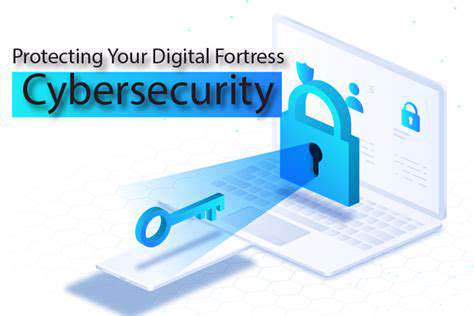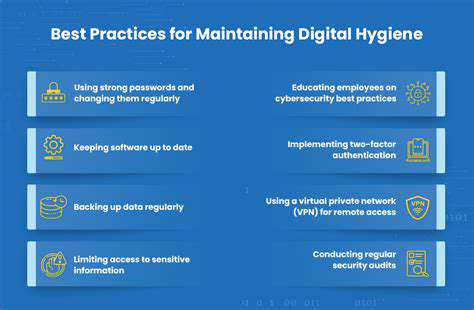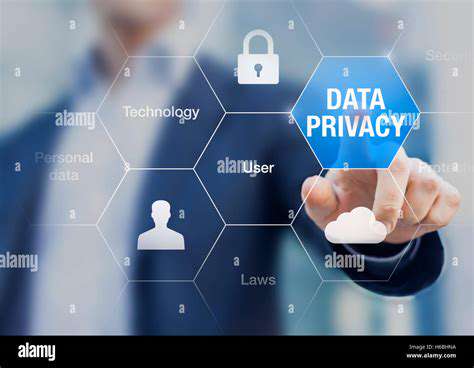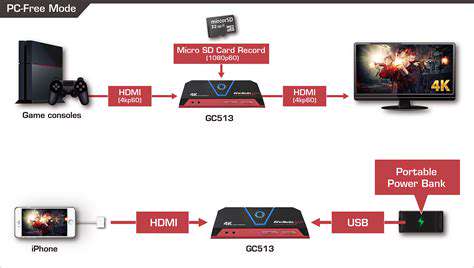How to Improve Your Online Privacy Today
Choosing Strong and Unique Passwords
Creating robust passwords is paramount to online security. A weak password is like an unlocked door, inviting hackers to access your accounts and sensitive information. Instead of relying on easily guessed combinations like password123 or your pet's name, opt for a complex mix of uppercase and lowercase letters, numbers, and symbols. A strong password should be at least 12 characters long and ideally include a variety of these elements for maximum protection. Remember, the more complex the password, the harder it is for hackers to crack.
Consider using a password manager. These tools generate and store strong, unique passwords for all your online accounts, eliminating the need to remember them all. This not only enhances security but also prevents the reuse of weak passwords across multiple platforms. Password managers are a powerful tool for anyone who prioritizes online safety and seeks to minimize the risk of unauthorized access.
Avoid using the same password for multiple accounts. This is a common mistake that significantly compromises security. If one account is compromised, hackers gain access to all accounts associated with the same password. By creating unique, complex passwords for each account, you dramatically increase the level of protection and limit the damage from a potential breach.
Implementing Multi-Factor Authentication (MFA)
Multi-factor authentication (MFA) adds an extra layer of security to your accounts beyond just a password. It requires more than one form of verification to access your account, such as a code sent to your phone or a biometric scan. By enabling MFA, you significantly reduce the risk of unauthorized access, even if a hacker manages to obtain your password. It's an incredibly effective security measure that should be implemented whenever possible.
Many online services now offer MFA, and it's highly recommended to utilize it whenever available. This extra step of authentication adds a substantial layer of protection, safeguarding your accounts from unauthorized access attempts. By implementing MFA, you're actively taking steps to fortify your online security and protect your personal information.
Actively monitoring your accounts for suspicious activity is crucial. Be vigilant about any unusual login attempts or unexpected notifications. By staying informed and responsive, you can quickly identify and address potential security threats before they escalate into significant issues. Regularly reviewing account activity is key to maintaining robust online security.
Checking your accounts regularly for suspicious login attempts or unusual activity is important. Promptly addressing any concerns related to potential breaches can minimize the impact of security incidents. Knowing how to spot suspicious patterns of activity is a critical part of online security hygiene.
Securing Your Devices: Protecting Your Digital Fortress

Protecting Your Devices from Malware
Malware, short for malicious software, is a significant threat to modern devices. It can infiltrate your systems through various means, including infected attachments, malicious websites, and compromised software. This infiltration can lead to severe consequences, ranging from data breaches to complete system failures. Understanding the nature of malware and the methods it employs is crucial for effective protection.
A strong defense against malware starts with vigilance. Be cautious about clicking on suspicious links or downloading files from untrusted sources. Regularly updating your operating system and software applications is also paramount, as these updates often include crucial security patches that address known vulnerabilities.
Importance of Strong Passwords
Strong passwords are the first line of defense against unauthorized access to your accounts. A simple password is easily guessed or cracked, leaving your sensitive information vulnerable. Employing a combination of uppercase and lowercase letters, numbers, and symbols creates a significantly more robust password that is harder to decipher. Consider using a password manager to generate and store complex passwords securely.
Beyond individual password strength, consider implementing multi-factor authentication (MFA) whenever available. This adds an extra layer of security, requiring a second verification method (like a code sent to your phone) beyond a simple password.
Utilizing Firewall Protection
A firewall acts as a barrier between your device and the internet, monitoring and controlling incoming and outgoing network traffic. It helps to prevent unauthorized access to your device and can detect and block malicious activity. Configuring and maintaining a firewall is an essential step in securing your devices. A well-configured firewall can significantly reduce the risk of cyberattacks.
Regular Software Updates
Software updates are not just about new features; they often include critical security patches. These patches address vulnerabilities that could be exploited by malicious actors. Regularly updating your operating system and applications is a proactive measure to strengthen your defenses. This proactive approach can prevent many potential security breaches.
Data Backup and Recovery Strategies
Data loss can be devastating, particularly if you don't have a backup strategy. Backing up your important files and data on a regular basis is crucial. This could include cloud storage, external hard drives, or a combination of both. Having a recovery plan in place allows you to restore your data in the event of a disaster or cyberattack, minimizing the impact of data loss.
Using Antivirus and Anti-malware Software
Implementing robust antivirus and anti-malware software is a crucial component of a comprehensive security strategy. These programs actively scan your system for threats and can quarantine or remove malicious software before it can cause damage. Using up-to-date antivirus and anti-malware solutions will significantly reduce the chances of malware infection. Regularly updating these programs is essential to maintain their effectiveness.
Term life insurance is a type of life insurance that provides coverage for a specific period, typically ranging from 10 to 30 years. During this time, if the insured person passes away, the beneficiaries receive a death benefit. This benefit amount is a fixed sum agreed upon at the time of policy purchase. Understanding the fundamental principles of term life insurance is crucial to making informed decisions about your financial security and the protection of your loved ones.
Minimizing Data Collection: Limiting the Footprint
Minimizing Data Collection: The Importance of Purpose
Understanding the why behind data collection is crucial for minimizing your online footprint. Every bit of information collected, from website visits to app usage, contributes to a larger profile. Consciously defining the specific purposes for collecting data allows for a more targeted approach, ensuring you're only gathering what's absolutely necessary for the intended function. This focus on purpose helps prevent the unintentional accumulation of data beyond its intended use, a critical element in preserving privacy.
Without clear, defined purposes, data collection often expands beyond its initial intent. This uncontrolled growth can lead to the unintentional creation of detailed profiles about users, potentially revealing more information than intended or desired. Defining the specific goals for data collection ensures you're only gathering the necessary data, minimizing the potential for misuse or unintended consequences.
Data Minimization Techniques for Enhanced Privacy
Implementing data minimization techniques is essential for responsible data handling. This involves carefully selecting the data points necessary to fulfill a specific function or task. For example, instead of collecting detailed location data for every interaction, consider alternative, less intrusive methods, such as using aggregated or anonymized location data. These methods effectively reduce the amount of personal information collected while still achieving the desired outcomes.
Another technique is to employ data masking or anonymization. This involves modifying or removing personally identifiable information (PII) from collected data. By replacing specific details with pseudonyms or generic values, the privacy of individuals is maintained, even if the data is stored for analysis or research purposes. This careful handling of data significantly contributes to a smaller online footprint.
Choosing Privacy-Focused Tools and Services
Selecting tools and services designed with privacy in mind is a key strategy for minimizing data collection. Many platforms now offer options for enhanced privacy controls, such as limiting data sharing or enabling data deletion. Actively seeking out these features and options allows users to take a more proactive role in managing their online data and reducing their digital footprint.
Furthermore, exploring alternative services that prioritize privacy can be a powerful step. By shifting to platforms that employ more stringent data handling practices, you can significantly reduce the amount of information collected and shared about you. This conscious selection of privacy-focused tools and services is essential for maintaining control over your online presence.
Strategic Data Deletion and Retention Policies
Establishing clear data deletion and retention policies is crucial for minimizing the long-term impact of data collection. These policies should outline how long data is stored, under what conditions it might be deleted, and what steps are taken to ensure the secure disposal of outdated or unnecessary information. This proactive approach to data management helps ensure that data is not retained indefinitely, reducing the overall data footprint.
Regularly reviewing and updating these policies is essential as technologies and user needs evolve. Staying informed about the latest privacy best practices and adapting your policies accordingly will help you minimize the amount of data retained over time. This consistent effort to manage data retention is key to a smaller and more controlled online footprint.
Transparency and User Control in Data Collection
Promoting transparency in data collection practices is paramount. Clear and concise explanations of how data is collected, used, and shared should be readily available to users. This transparency fosters trust and empowers users to make informed decisions about their data. Users should have a clear understanding of how their data is being utilized and the potential implications of that use.
Implementing user controls over data collection is equally important. Giving users the ability to adjust their data sharing preferences, opt out of certain data collection practices, or directly manage their data is essential. This level of control empowers users to actively participate in managing their own online footprint and take ownership of their personal data.

Read more about How to Improve Your Online Privacy Today
Hot Recommendations
- Review: The New [Specific Brand] Smart Lock Is It Secure?
- Best Budget Studio Monitors for Music Production
- Top Flight Simulation Peripherals (Joysticks, Throttles, etc.)
- Top Portable Scanners for Document Management On the Go
- Reviewing the Latest Smart Air Purifiers for Your Home
- Best Portable Photo Printers for Travelers and Memory Keepers
- The Future of Personal Transportation Beyond Cars (Hyperloop, eVTOL)
- Top Network Monitoring Tools [Free & Paid Options]
- Understanding the Tech Behind mRNA Vaccines [A Look Inside]
- Guide to Choosing the Right Gaming Chair for Ergonomics










![What is Synthetic Biology? [Engineering Life]](/static/images/25/2025-07/DefiningSyntheticBiology3ARewritingtheCodeofLife.jpg)
![Top Smart Lighting Kits for Gamers [Sync with Games]](/static/images/25/2025-07/BeyondtheLights3AEnhancingYourGamingSetup.jpg)